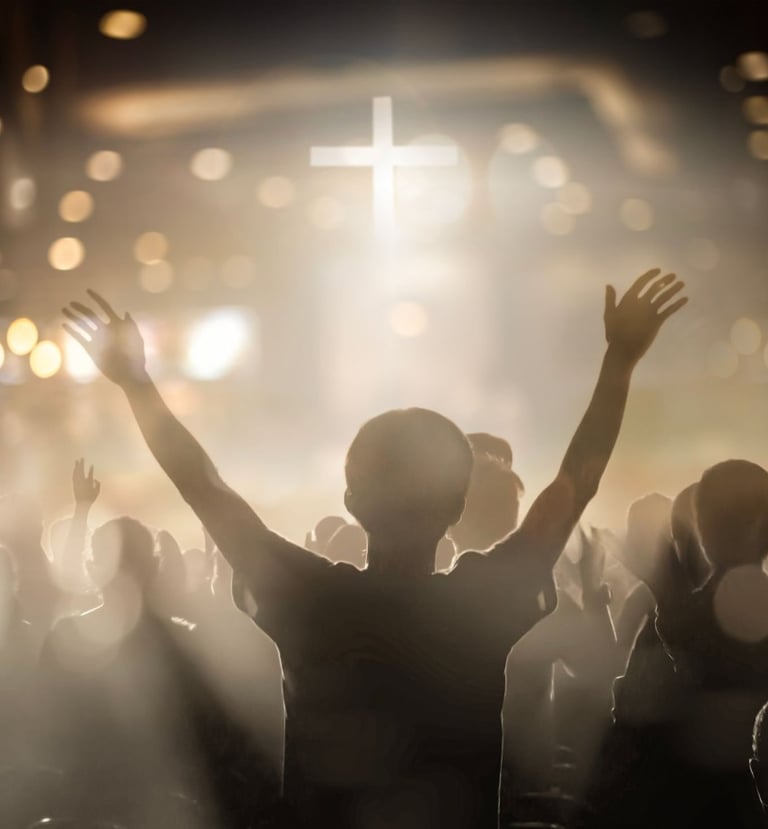How God Has Always Existed – If No One Created God
Like many of you I have kicked around ideas of religion and faith. From maybe there is a God, maybe there is not. Jesus is real, Jesus may be fake. Well he was real but maybe he was just a man. What about all these other religions and what do they teach? What if there is nothing and we came from nothing. Over the years here are some things that got me over the hump. And to realize Jesus is the key to unlocking the truth. The truth that is based in design and love. Unfortunately the world is loud, we get distracted and forget what we are here for.


God was never created—because God is the source of creation itself.
Creation requires time, cause, and space—but God exists outside those things. Everything that begins to exist has a cause. But something eternal, by definition, has no beginning—and thus needs no cause.
Time itself had a beginning.
And whoever started time is not bound by it.
Imagine this:
- You’re watching a movie. There’s a beginning, middle, and end.
- But the director is not in the movie.
- The director exists outside of time in the film.
- That’s what God is like: not an actor inside creation—but the Author of it.
🔥 THE CORE EXPLANATION: “Why No One Created God”

🧠 SCIENCE MEETS SPIRITUAL TRUTH
Even science says time had a beginning.
The Big Bang wasn’t just a burst of matter—it was the start of time and space.
So whatever caused the Big Bang must be timeless.
You can’t say, “Who created God?”
That’s like asking, “What’s north of the North Pole?”
It’s a flawed question—because it assumes time existed before the eternal.
God is the uncaused cause.
The infinite mind behind reality.
Not a being in creation—but Being itself.
💥 FINAL ANALOGY:
Think of God like light.
Light doesn’t need darkness to exist—
but darkness is just the absence of light.
In the same way, everything else is temporary—
but God is the source that makes everything else possible.
The Bible teaches we were created for a relationship with God. and He created us with purpose and design. The world teaches we are here by chance. What about evolution and the big bang? Lets analyze the statistical probability of both.
🧒 To a child:
“Everything we see had a beginning. But someone had to make the first thing. That someone is God. And He had no beginning—because He made beginnings.”
🧔 To a seeker:
“If something created God, you’d ask what created that. It would go on forever. But at some point, there has to be a first—something that just is. That’s what God means. He’s the One who was never made.”
🧠 To a logical thinker:
“All change, movement, and matter require a cause. But something eternal doesn't change, doesn't start—it just is. That’s why God isn’t ‘made’—He’s the reason anything else exists.”
✝️ BIBLICAL SUPPORT:
“Before the mountains were born or you brought forth the whole world, from everlasting to everlasting you are God.” —Psalm 90:2
“I am the Alpha and the Omega,” says the Lord God, “who is, and was, and is to come, the Almighty.” —Revelation 1:8
“In the beginning, God created...” (Not: In the beginning, God was created)
🔁 BREAKING IT DOWN FOR DIFFERENT PEOPLE:
Chance vs. Design — A Pure-Probability Analysis


Without invoking religion or empirical science, we can model “intelligent design” as goal-directed compression:
If an outcome can be succinctly described by a program/blueprint of KKK bits (Kolmogorov-style description length), then a designer/organizer with that KKK-bit description can produce the target with probability ~1 (given the description), while the prior weight of such a description in a universal prior is ~2−K2^{-K}2−K.
Under Chance (H₀): likelihood of target ≈2−I\approx 2^{-I}≈2−I.
Under Design (H₁): marginal ≈2−K\approx 2^{-K}≈2−K (cost is the description length, not the hit in the raw search space).
Bayes factor (H₁ vs H₀) using pure description lengths:
BF≈2−K2−I=2 I−K.\text{BF} \approx \frac{2^{-K}}{2^{-I}} = 2^{\,I-K}.BF≈2−I2−K=2I−K.
If the required specified information III (what makes the target “special”) is much larger than the shortest description KKK (how compactly an organizer can encode the plan), design dominates exponentially.
Example Bayes factors
If I=1000I=1000I=1000 bits and K=200K=200K=200 bits ⇒ BF≈2800≈10240\text{BF} \approx 2^{800} \approx 10^{240}BF≈2800≈10240.
If I=700I=700I=700 and K=400K=400K=400 ⇒ BF≈2300≈1090\text{BF} \approx 2^{300} \approx 10^{90}BF≈2300≈1090.
If III and KKK are close (say 500 vs 450), the advantage shrinks (BF≈250≈1015\text{BF}\approx 2^{50}\approx 10^{15}BF≈250≈1015 — still enormous).
Only when K≥IK \ge IK≥I (i.e., the design description is as complex as the target itself) does design not beat chance.
Pure-probability verdict: Any scenario where outcomes are highly specified (large III) but can be concisely planned (smaller KKK) overwhelmingly favors intelligent organization over blind chance.
3) Compare to “intelligent organization” (algorithmic prior only)
4) Sensitivity: what if the target set is “looser”?
You might argue the target isn’t a single microstate but a broad family of workable states—i.e., larger MMM ⇒ smaller III. That’s already baked into III: it measures all workable configurations. The question becomes: How dense is function within the full space?
If function is dense (small III), chance is plausible.
If function is sparse (large III), chance collapses exponentially.
The design-vs-chance odds depend only on III vs KKK.
5) Bottom line (probability-only)
Blind chance model: Hitting multiple, highly specified targets multiplies improbabilities; even a few hundred bits of specification make chance effectively zero (e.g., 10−20010^{-200}10−200 to 10−70010^{-700}10−700 and beyond).
Intelligent-organization model: If the same targets are compressible—i.e., generable from shorter descriptions KKK—then the odds ratio scales like 2I−K2^{I-K}2I−K, which is astronomically in favor of design whenever I≫KI \gg KI≫K.
Final assessment
On pure probability grounds (information & combinatorics), the intelligent-organization hypothesis is vastly more probable than blind random chance whenever the observed order/structure entails large specified information that can be succinctly generated (i.e., I≫KI \gg KI≫K). If you believe the required structure is only weakly specified (small III), then chance could compete—but for anything requiring hundreds to thousands of effective bits of specification, chance is crushed.
1. The core idea
Every highly ordered thing (like Earth, DNA, or a conscious mind) needs a lot of very specific “instructions” to exist.
The more instructions required, the less likely it is to happen by random chance.
Think of it like guessing a password:
4-digit PIN → 1 in 10,000 chance (0.01%).
20-character password → practically impossible to guess by luck.
2. Step-by-step examples
Earth-like planet
Imagine tossing dice to get the exact same number 10 times in a row. Odds ≈ 1 in 60 million.
That’s about the probability of randomly getting Earth’s position, tilt, atmosphere, and stability all lined up.
Self-replicating molecules
Like getting the correct 100-piece jigsaw puzzle by shaking pieces in a box until they land correctly. Odds so low it’s basically zero.
DNA complexity
DNA has billions of “letters” in a precise order.
Randomly assembling even a 1-page sentence of letters by chance has a probability so low you’d need trillions of universes trying forever. DNA is much, much longer.
Consciousness
Conscious thought is like having a computer code not only run without errors, but also write and edit itself. Random chance coding that is virtually impossible.
3. Percentages (approximate to make it relatable)
Earth’s conditions by luck → 0.00000001% chance
Self-replication by luck → 0.0000000000001% chance
DNA-level order by luck → way less than 1 in a trillion-trillion
Consciousness by luck → beyond any practical number
Put together → chance is so close to 0% that for all practical purposes, it’s impossible.
4. Design comparison
Now imagine someone planning it:
Writing down instructions for the jigsaw puzzle → 100% chance it gets assembled correctly.
Programming a computer with a short code that builds the system → probability close to 100%.
Design is like knowing the password — you don’t have to guess billions of times.
5. Bottom line
By chance: Almost impossible (near 0%).
By design: Almost certain (near 100%).
Analogy:
Rolling dice and expecting them to spell “LIFE” in perfect order = chance.
Writing “LIFE” with a pen = design.
👉 So in everyday terms: the odds of Earth and life happening by random accident are basically like winning the lottery every day for a year straight. Versus with design, it’s like buying the winning ticket on purpose.


Simplified Language

The Statistical Probability of the Miracle of Jesus Surviving 2000+ years :
#1. The Impossible Odds
- Starting Conditions (30 AD Judea - MIDDLE OF THE DESERT):
- Illiterate peasant from nowhere (Nazareth population: 200-400)
- No wealth, no army, no political connections
- Roman Empire actively crushed rebel movements -Killing everyone involved
- Probability of Success:
- Dozens of other "messiahs" appeared in this period - all forgotten
- Standard historical pattern: Such movements die with their founder
#2. The Viral Spread
Growth Against All Odds:
- Within 300 years: Became state religion of Rome
- Current impact: 2.4 billion followers worldwide
Key Factors:
1. Moral Revolution:
- Care for sick during plagues
- Elevation of women and slaves
2. Martyrdom Effect:
- Persecution increased credibility
3. Memetic Strength:**
- Simple, reproducible teachings
- Empowered the marginalized
#3. The Crucifixion Paradox
- Expected Outcome: Movement dies with leader
- Actual Outcome: Execution became founding myth
- Statistical Anomaly: No similar movement in history survived this way
#4. Modern Equivalent?
Why It Would Fail Today:
- Immediate "fact-checking" and censorship
- Short attention spans
- Institutional resistance
Why It Might Work:
- Internet enables rapid spread
- Global dissatisfaction with systems
- Hunger for authentic meaning
Conclusion: Statistical Miracle
- Mathematical probability of this success: Near-zero
- Two Possible Explanations:
1. Divine intervention
2. Most perfect ideological truth in history
Evolution people have no power and no soul, Design created by God people have Power.
So what does this all mean?
It means that Jesus, Who openly claimed to be God is 1 of 3 things:
1) A liar who deceived the world for over 2000 year, whose message people were willing to go to war for, die for and ultimately changed the world.
2) The biggest lunatic of all time ( see above)
Or
3) He was telling the truth.
The choice is yours. But only 1 of those 3 things can be true.
If you believe that only the truth could impact the world.
Open your Bible read the sermon on the mount.- This is what he taught. Don't have a Bible click here for an online bible.
The Power of Forgiveness
1. What Forgiveness Is (And Isn’t)
Forgiveness is not:
- Saying what happened was okay
- Excusing injustice or evil
- Letting people back into your life without discernment
- Forgetting
Forgiveness IS:
- Releasing the spiritual and emotional grip that pain, betrayal, or injustice has on you
- Unhooking yourself from the person/situation so it no longer controls you
- Breaking the spiritual contract of bitterness and vengeance
- Choosing healing over resentment
“Forgiveness is unlocking the door to set someone free… and realizing you were the prisoner.” – Lewis Smedes
2. What Happens When You Don’t Forgive
Unforgiveness = Poison to the body, mind, and soul:
- Neuroscience: Chronic resentment activates the amygdala and stress response — cortisol floods your body.
- Heart Health: Forgiveness improves heart rate and reduces risk of cardiac events.
- Trauma Loop: Keeps your brain in a trauma pattern.
- Spiritual Bondage: According to scripture, unforgiveness becomes a spiritual stronghold (Matthew 18:34–35).
3. What Happens When You DO Forgive
Forgiveness breaks chains:
- Peace returns
- Mental clarity improves
- Healing accelerates
- Spiritual doors open
- You reclaim your energy
4. Jesus’ Radical Forgiveness Model
“Father, forgive them, for they know not what they do.” (Luke 23:34)
Jesus forgave in real time while being murdered. He taught that we must forgive to be forgiven (Matthew 6:14–15).
Forgiveness is a spiritual law.
5. Scientific Studies on Forgiveness
- Stanford Forgiveness Project: 70% reduction in depression, improved emotional health.
- Johns Hopkins: Lower stress, better immune function, and reduced heart disease risk.
6. Why Most People Struggle with Forgiveness
- Confuse justice with revenge
- Believe forgiveness = weakness
- Wait until they "feel like it"
- Don’t understand the spiritual mechanics
- Fear losing power when holding on to pain
7. How to Forgive (Even When It Feels Impossible)
Step-by-step process:
1. Acknowledge the pain — don’t suppress it.
2. Speak the truth — “I was hurt. It was wrong.”
3. Choose to forgive — not because they deserve it, but because you deserve peace.
4. Name the person and offense aloud.
5. Pray or speak blessing over them.
6. Ask God to heal the wound and remove bitterness.
7. Repeat as needed.
8. What If They Keep Hurting You?
Forgiveness ≠ Reconciliation. You can:
- Forgive and set boundaries
- Walk away without hate
- Love from a distance
9. Forgiveness and Generational Healing
When you forgive, you break:
- Generational cycles of bitterness
- Learned hatred and trauma
- Spiritual strongholds affecting your children
10. Forgiveness Is Spiritual Warfare
Unforgiveness is a demonic foothold. Forgiveness:
- Closes doors to tormentors (Matthew 18)
- Disarms enemy accusations
- Makes room for God’s justice
Final Words
“To be a prisoner of someone’s sin against you is to let their evil live rent-free in your soul. Forgiveness is the eviction notice.” – Truth Mode